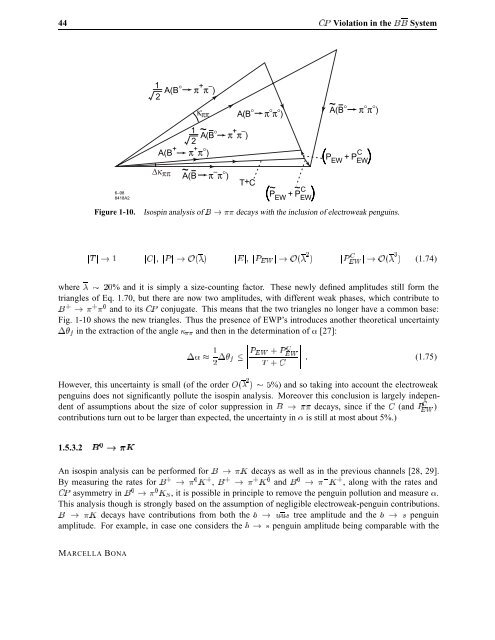Violation in Mixing
Violation in Mixing
Violation in Mixing
Create successful ePaper yourself
Turn your PDF publications into a flip-book with our unique Google optimized e-Paper software.
44 �È <strong>Violation</strong> <strong>in</strong> the �� System<br />
6–98<br />
8418A2<br />
1<br />
2<br />
A(B° π°π°)<br />
A(B° π + π – ~<br />
)<br />
A(B + π + κππ<br />
1<br />
2<br />
π°)<br />
Δκππ<br />
A(B° π + π – )<br />
~<br />
A(B π – π°)<br />
T+C<br />
~ ~<br />
C<br />
PEW + PEW ~<br />
A(B° π°π°)<br />
C<br />
PEW + PEW Figure 1-10. Isosp<strong>in</strong> analysis of � � �� decays with the <strong>in</strong>clusion of electroweak pengu<strong>in</strong>s.<br />
�Ì �� ���� �È��Ç � ���� �È�Ï� �Ç � �È � �Ï� �Ç � (1.74)<br />
where � � % and it is simply a size-count<strong>in</strong>g factor. These newly def<strong>in</strong>ed amplitudes still form the<br />
triangles of Eq. 1.70, but there are now two amplitudes, with different weak phases, which contribute to<br />
� � � � and to its �È conjugate. This means that the two triangles no longer have a common base:<br />
Fig. 1-10 shows the new triangles. Thus the presence of EWP’s <strong>in</strong>troduces another theoretical uncerta<strong>in</strong>ty<br />
¡�� <strong>in</strong> the extraction of the angle ��� and then <strong>in</strong> the determ<strong>in</strong>ation of « [27]:<br />
¡« � ¡�� �<br />
¬<br />
¬ È�Ï È � �Ï<br />
Ì �<br />
¬<br />
¬ � (1.75)<br />
However, this uncerta<strong>in</strong>ty is small (of the order Ç � � �%) and so tak<strong>in</strong>g <strong>in</strong>to account the electroweak<br />
pengu<strong>in</strong>s does not significantly pollute the isosp<strong>in</strong> analysis. Moreover this conclusion is largely <strong>in</strong>dependent<br />
of assumptions about the size of color suppression <strong>in</strong> � � �� decays, s<strong>in</strong>ce if the � (and È � �Ï )<br />
contributions turn out to be larger than expected, the uncerta<strong>in</strong>ty <strong>in</strong> « is still at most about 5%.)<br />
1.5.3.2 � � �Ã<br />
An isosp<strong>in</strong> analysis can be performed for � � �à decays as well as <strong>in</strong> the previous channels [28, 29].<br />
By measur<strong>in</strong>g the rates for � � � Ã , � � � Ã and � � � Ã , along with the rates and<br />
�È asymmetry <strong>in</strong> � � � ÃË, it is possible <strong>in</strong> pr<strong>in</strong>ciple to remove the pengu<strong>in</strong> pollution and measure «.<br />
This analysis though is strongly based on the assumption of negligible electroweak-pengu<strong>in</strong> contributions.<br />
� � �à decays have contributions from both the � � ÙÙ× tree amplitude and the � � × pengu<strong>in</strong><br />
amplitude. For example, <strong>in</strong> case one considers the � � × pengu<strong>in</strong> amplitude be<strong>in</strong>g comparable with the<br />
MARCELLA BONA















